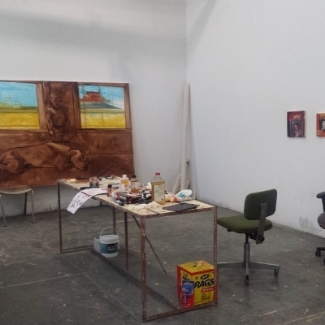Painters Painting the Black Body
Mario Moore
Painting the Black body in the expanse of history has been a tool for exploitation, admiration, jealousy, sexuality, exoticism and many other things. Usually through the hands and eyes of white male artists, the Black body has served these positions ultimately to the service of the white figures that occupy the forefront of these works of art. There are some historical exceptions of white artists honoring a Black figure, like Velazquez painting of Juan de Pareja or the painting of Alexandre Dumas by Oliver Pichat. But even these anomalies in history are only a small speck in the large canon of art.
Lately, there have been artists who are turning the tables on this narrative—Black painters that are devoted to representing the Black body through their eyes. But this isn’t anything new. The artist Henry Ossawa Tanner gave us insight into Black lives through his painterly hand in the 19th century. There were other Black artists working during that time but many stayed clear from representing the Black figure because they were afraid they would be unable to make a living. Today, there are more Black painters taking up the mantel to represent Black figures within their work. With the new retrospective of Kerry James Marshall, one of the leaders in putting the Black body at the forefront of his painting narrative, there are countless Black painters working today who are focusing on the representation of Black people in their work. Here is the first installment of four contemporary painters that focus primarily on representing the Black body:
1. Jennifer Packer
Untitled, 24 x 36, Oil on canvas, 2014
And Dreaming, 10 x 20, Oil on canvas, 2015
Looking at Jennifer’s work, the viewer can get lost in the form and absence of color in certain areas that have been wiped out. But this absence of color or erasure can be seen as a protective covering for the lives of the Black figures that she represents. We are at the mercy of what she wants to reveal and what she wants to hide. You may see a knee or the face of a figure in a field of color. She provides a safe space for the Black figure to reside that was ultimately exploited throughout history. She is a painter that gives us an intimate psychological view of figurative painting.
Check out more of her work here: Jennifer Packer
2. Derek Fordjour
Double Down, 60 x 40, Oil on panel, 2016
Fearless Foursome, 2013
I have not seen many of Derek’s pieces in person but from what I have seen the pieces are always dope. His work uses games as metaphors and how they can be applied to our living experiences. From board games, to the confetti of winning a championship, and basketball uniforms we see all there is about the spectacle of achievement and failure. There are often images of blocks and athletes that stand upon them within his paintings. I can’t help but draw comparisons between the slave auction blocks and the selling of Black bodies that represent the athletes within his work.
See more of his work here: Derek Fordjour
3. Tylonn Sawyer
Congregation MLK, 120 x 48, Oil on canvas, 2015
Class Photo #1 Baldwin, 72 x 48, Oil on canvas, 2015
I’m used to seeing Tylonn’s large portrait paintings. But in his recent series, Sawyer uses historical black figures as masks. They act as the embodiment of revolution and they grace the faces of multiple figures in his paintings. Essentially, these paintings are a call to action. They allow us to look at the times we live in and imagine how Dr. King or Nina Simone would take action in the present.
Check out more of his work here: Tylonn Sawyer
4. Senghor Reid
Senghor’s paintings show Black figures bathing in colorful light. His paintings show delight in the texture and body of paint. He is unafraid to use color and his figures often sit in front of the clouds. His pieces show a pleasure in the act of painting but also show a very intense gaze from the people within his paintings that contrast the bright colors seen in his work.
Check out more of his work here: Senghor Reid
Please let me know of any other painters you think I should feature next. Comment below.
Peace,
Mario










